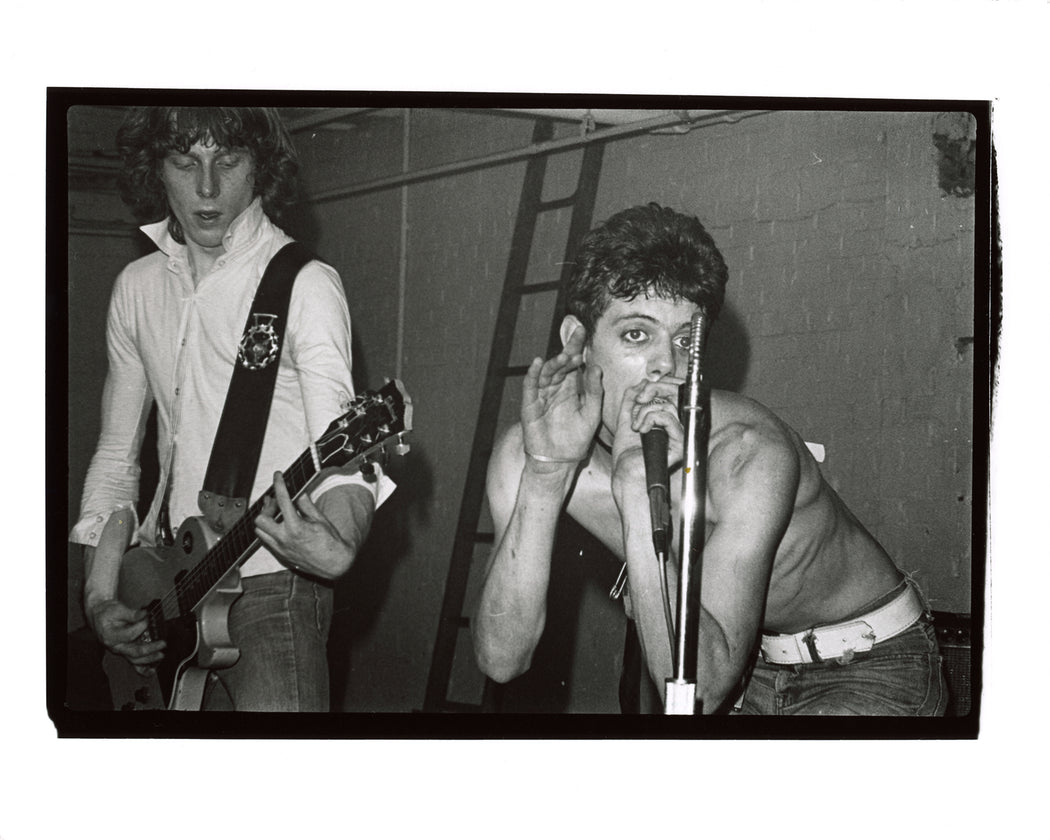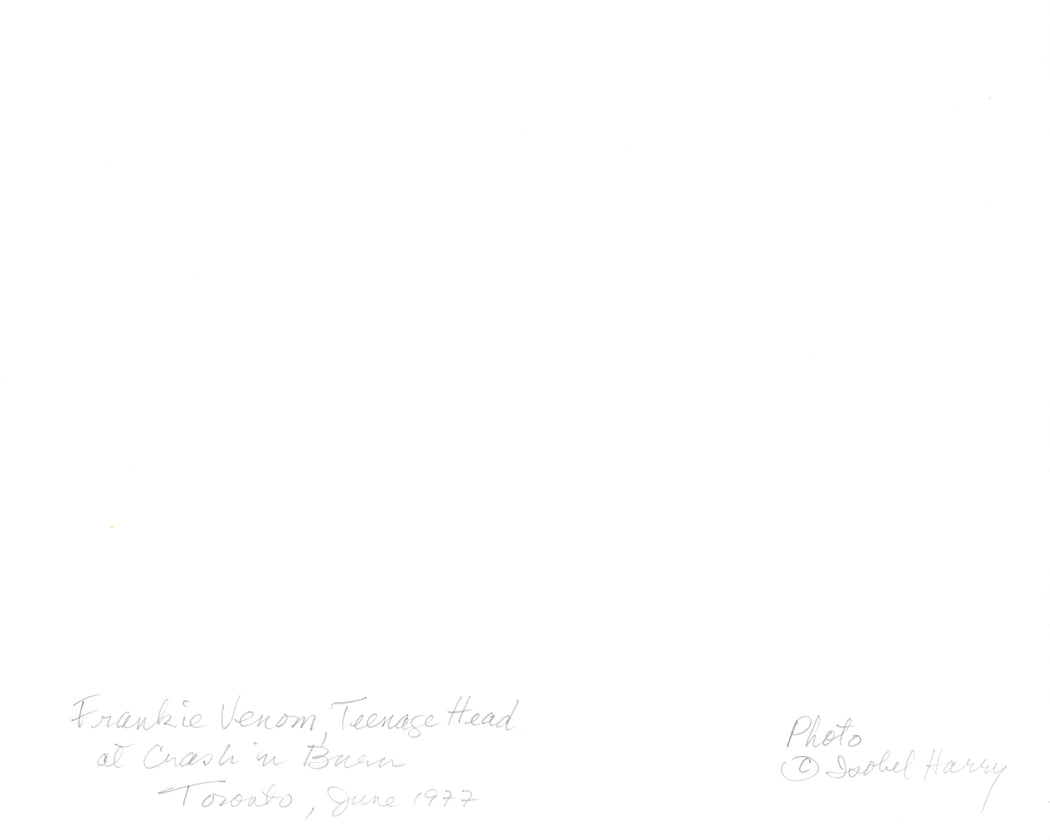


Isobel Harry
Frankie Venom (right) and Gord Lewis (left), Teenage Head, Crash ‘n’ Burn, Toronto by Isobel Harry
 Toronto, ON)
Toronto, ON)
Learn about our Shipping & Returns policy.
Have a question? Read our FAQ.
- Artwork Info
- About the Artist
-
June 1977
Gelatin silver print
Signed, titled, and dated, in pencil, au verso
Printed circa 1977 -
Isobel Harry is a photographer and journalist. Her photographs explore artistic expression, especially as manifested in performances by artists and musicians and in her own self portraits. As a young photographer, her curiosity was intense, compelling her to capture what she saw in people’s faces, in her own face, discovering the artfulness in life through her camera. Everything became subjective, filled with her own emotions. Each portrait recorded feelings made tangible in print and each performance made the symbolic visible.
In describing her aesthetic, Harry says, “My photos were always about what moved me visually; it was a feeling, an intuition to carry the camera and shoot what was there. Curiosity, and just always carrying the camera, reacting to what was around me, photographing where I was. Documenting but also hoping to reveal something of an inner life.”
Born in Ottawa, Canada, Harry graduated with a BA in English and French literatures from Carleton University. After hitchhiking around Europe with a backpack and her best friend, Isobel settled in London where she was hired by Time Out magazine and shortly began writing columns and doing paste-ups in the layout studio. Her first published article was about London’s new “women’s lib” groups.
She returned to Canada, settling in Toronto where she found work at A Space, an artist-run gallery, the first of its kind in the city, if not the country. There, she was handed her first 35mm camera and assigned the job of documenting spaces in the city that were suitable for artists and performers. Having previously only used a Kodak Instamatic, Harry ruined her first outing with the new 35mm by opening the camera without first rewinding the film. Despite losing her first roll, she knew that from then on, the camera would be her ‘backstage pass’ to everything interesting. At A Space, photographer David Hlynsky enlisted Harry to help build the darkroom and taught her how to process negatives and prints in the chemical baths. Soon after she participated in her first group exhibition in the upstairs gallery.
Harry began photographing herself using a 30ft-long shutter release cable with a squeeze bulb, inspired by research into the early portraits of Julia Margaret Cameron and Tina Modotti and the fashion photographs of Sarah Moon. In the 70s, women were reclaiming their rightful places in the world as autonomous beings, not defined by men or marketing. She began to explore female and feminine imagery by playing with costume and disguise.
When Toronto’s punk scene exploded at the Crash ‘n Burn club in the summer of 1977, Isobel photographed local bands, including the Viletones, Teenage Head, the Curse, the Poles, among others. She captured images of Fashion Burn, a witty catwalk of homemade punk couture designed by David Buchan and Dawn Eagle, a heady mix of unruly musicians, avant-garde artists and style rebels.
After several visits to Jamaica beginning in 1974-75, Harry traveled back to the politically explosive city of Kingston in April, 1978 on her first-ever photo assignment, to cover the historic One Love Peace Concert for the Toronto Star’s Weekend magazine. The years 1976-1980 were the most violent in the country’s history, culminating in over 800 politically-motivated gun killings in the 1980 election year alone, carried out by enforcers in the city’s ghettoes, armed and paid by the two main political parties to wipe out their opposition.
In 1976, there was an assassination attempt on Bob Marley’s life at his Kingston home, and he went into exile in England. By 1978, gunmen in the opposing factions negotiated a truce, and Marley was persuaded to return to help broker a permanent peace; a Peace Concert was planned as part of that process. Marley would only allow Harry to photograph him if she learned more about the Peace Council, the local grassroots group attempting to steer the fragile process. It was only later that she fully grasped the outlaw identities of the ‘peace councillors’ and understood the importance of these herculean attempts to resolve the deadly conflicts. On the night of the Peace concert, Harry shot from the stage until she was thrown down a flight of steps by security as the prime minister and the leader of the opposition were led up to stand in the sudden blaze of white lights illuminating Bob Marley, holding both their hands up in a symbolic gesture of unity. She managed to squeeze through the frenzied crowds to the front of the stage, forgetting everything but the tumult of the moment, unable to adjust her lens for the dramatic change in lighting and clicking the shutter anyway. The trip had a profound influence on her. The huge disparities of life in Jamaica that were the legacy of hundreds of years of slavery, the stark realities of poverty, class and colour hierarchies continue to delineate the daily lives of its people. The powerful and evocative response of artists and musicians spoke to the country’s persistence through hardship and suffering.
Upon her return to Canada, Harry began an association with Canadian reggae band Truths and Rights, serving as photographer and publicist for several years. She promoted Caribbean music through major profiles and cover photographs while Associate Editor at the Canadian Composer and wrote think-pieces for cultural news magazines Centrefold and FUSE. Jamaica changed her consciousness of the world and her place in it.
In 1989, Harry began work in the field of human rights, first with Peace Brigades International’s Central America Committee. In 1992, she began work with PEN International (PEN Canada), first as International Programmes Director, then as Executive Director until 2010, alongside committed writers who advance the organisation’s mission ‘to defend freedom of expression and celebrate literature’ in over 100 countries. Harry advocated on behalf of political prisoners, particularly imprisoned and exiled writers and journalists worldwide, and for refugee rights, at the UN Commission on Human Rights in Geneva and New York and before governments internationally.
Harry now lives and works on Manitoulin Island, Ontario, Canada, inspired by the rich Indigenous culture of the Great Lakes region and the abundant nature and wildlife. She is a freelance writer and photographer for the local weekly newspaper and travel publications and is always keen to develop new projects in photography and writing to bring new life to her craft.
Harry’s photographs have appeared in numerous publications, including Toronto Life, the Globe and Mail, Macleans, Saturday Night, the Canadian Composer, Shades, Theaterwork, FILE, Image Nation and FUSE. Her photography has been exhibited at the Art Gallery of York University, the Art Gallery of Ontario, the Power Plant, the Art Museum at the University of Toronto, and is in the collection of the National Gallery of Canada.


